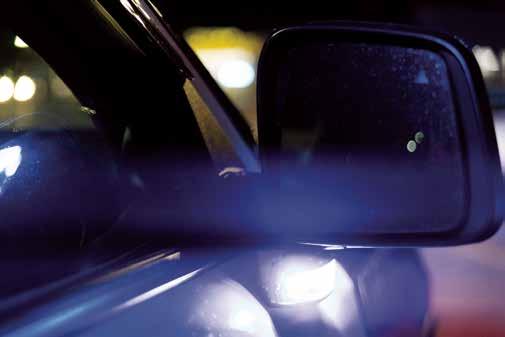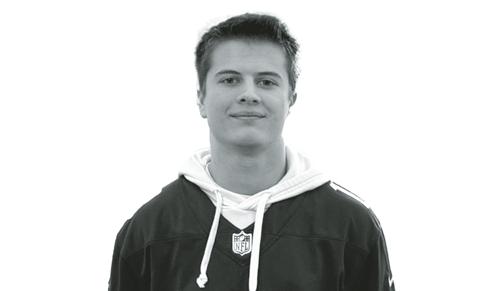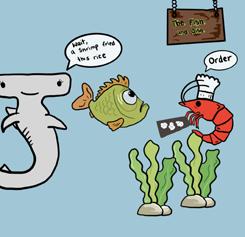Safety in



Ohio University is reviewing criteria in gift agreements, which can affect students of diverse backgrounds, in light of the U.S. Supreme Court’s ruling prohibiting affirmative action policies in college admissions last June. A university spokesperson said OU’s actions take into account advice sent to them from other experts in higher education and communication from Ohio Attorney General Dave Yost.
Faculty in the Journalism School have spoken out against the university’s decision to pause gift agreements, according to a previous Post report.
According to a university news release, the purpose of the review is to identify gift agreements that can have their language revised. OU is pausing affected scholarships that represent a “small but important subset” of annual awards. During this review, OU has decided that a few scholarships will continue.
Yost sent a letter in June stating that universities must not utilize race-conscious admissions following the SCOTUS case. He also wrote that citizens are empowered to sue state actors who “violate their constitutional rights,” and employees of institutions will not be entitled to qualified immunity if they are litigated on race-conscious admissions.
The Harvard case only mentioned race-based admissions and mentioned scholarships once in passing. According to Bethany McCorkle, who was quoted in a report by the Statehouse News Bureau, Yost told university leaders in a call in late January that compliance under the Harvard case includes scholarships.
“Although the Court did not expressly prohibit race-based scholarships, it indicated that ‘eliminating racial discrimination’ means eliminating all of it,’” McCorkle wrote in an email published by the Statehouse News Bureau. “Race-based scholarships discriminate on the basis of race in awarding benefits. Therefore, it would follow that such programs are unconstitutional.”
While the university has officially confirmed scholarships like the John Newtown Templeton Scholarship and the Appalachian and Urban Scholars program will continue into Fall 2024, Andrew Alexander, an alum of the Scripps School of Journalism, set up a scholarship with his wife Beverly, is unsure if his scholarship, the Andrew Alexander Scholarship, will continue.
He said if OU decided his scholarship could not continue to have a preference for people of diverse backgrounds, he would find a way to offer the scholarship privately to bypass the university.
“These types of scholarships are helpful in countering racial discrimination in society,” Alexander said. “From the standpoint of journalism, they’re important because if we have diversity amongst students, graduates will have more diverse newsrooms when they get hired, and when newsrooms are diverse, news coverage is more accurate.”
Larry Neumeister, an alum of the Scripps School of Jour-

nalism, helped establish the Clarence Page Scholarship for African American Students of Journalism in 2019. He said he had intended the scholarship to go to Black students, but he was told race-specific verbiage could not be used.
Initially, OU suggested going to the NAACP or other outside organizations to set it up privately. However, Neumeister had been told any large scholarship donation through the school would be matched for 50 cents for every dollar.
“I thought, ‘Well, it’s almost discriminatory for me to take it to a place somewhere else … where it won’t get that money that scholarships may be more geared toward white people would get,” Neumeister said. “The population that the scholarship is intended to serve should not be discriminated against by not getting access to some of that matching money.”
He said to work around the race-specific language, he complied with requirements but took advantage of the university’s offer to name it anything he wanted.
Associate Professor of Political Science Vincent Jungkunz said the university reviewing these scholarships to comply with Yost’s guidance demonstrates a backlash against diversity, equity and inclusion efforts in Republican policies.
“If the Harvard decision becomes a precedent that is applied to scholarships, then (the removal of diversity scholarships) is more consequential than the Harvard decision for students of color,” Jungkunz said.
According to the previous Post report, some members of the School of Journalism scholarship committee have decided to abstain from voting on scholarship recommendations because they are worried they will not be protected from litigation.
Beyond legal action, Jungkunz said he is concerned the removal of diversity scholarships will affect students’ livelihoods and education experience.
“Scholarship is so important … The relationship between race and socioeconomic status, the ability to pay for college is going to be much more difficult,” he said. “That’s where
it’s going to be really consequential for students from these various diverse backgrounds.
Jungkunz said there are a few options the university can take to continue to offer these scholarships. One is the pool and match system.
Pooling and matching puts all scholarship donations into a pool and distributes them based on merit. The source of the money and the student receiving the scholarship are only connected after the university conducts a race-neutral review.
Jungkunz said Chief Justice Roberts keeps the door open on race-based admissions in the wording of the Harvard case. He said the case stated universities cannot give any boost to people of diverse races, but applicants can write a narrative about how race impacted their lives in a meaningful way. He said the same reasoning can be used for scholarships if they are based on the Harvard case.
While there are growing concerns about the potential for legal actions toward faculty members, Jungkunz said he was unsure how the courts would react to a case like this.
“I don’t think that individual faculty who sit on a committee and process these things would likely face any kind of legal action,” Jungkunz said. “What would be more likely is that … the division at the university who deals with scholarships … would be sued.”
Jungkunz said because Yost’s letter threatens litigation against faculty, it could bankrupt them if they are held liable.
“It puts a shadow of legal jeopardy upon a lot of people,” he said.
Katie Millard contributed to this report.
The Ridge-id Security
An incident of destruction of property at one of the buildings at The Ridges was reported to the Ohio University Police Department.
OUPD took a report on the damage done to a chain link fence.
Need some rubber?
A caller informed the Athens County Sheriff’s Office that someone was dumping tires on her property.
She told deputies four tires were dumped under her trailer and that she didn’t know anyone who might have done it.
On Tuesday, this case was referred to the Sheriff’s Office Environmental Deputy for investigation.
I wanna pet the bomb dogs
Suspicious activity was reported to the Ohio University Police Department.
OUPD took note of a bomb threat, but the report was unfounded.
Nerf or nothin’
A minor waving a gun around Mill Street in Chauncey was reported to the Athens County Sheriff’s Office.
Upon arrival, deputies found that it was a toy gun. Offi-
cers returned the individual to his parents and returned to patrol.
Were your headlights on?
A traffic offense near parking lot 133 was cited by the Ohio University Police Department.
A woman was cited for failure to stay within the marked lanes.
Fast and furious
A man told the Athens County Sheriff’s Office that his vehicle was stolen earlier in the day and he had seen someone driving it on state Route 144.
Deputies patrolled the Stewart area but had negative contact.
If you break in, be quiet!
An alcohol offense in Clippinger Laboratories was reported by the Ohio University Police Department.
A student was charged with underage consumption of an intoxicating beverage.
Nasty neighbors
A neighbor dispute on Carr Road in Nelsonville was reported to the Athens County Sheriff’s Office.
Once deputies arrived, they spoke with all involved parties. The deputies determined that all parties equally contributed to the argument.
Sorority & Fraternity Life
Thursday, February 29
“I Can Buy Myself Flowers” Bouquet Making Workshop 7:00 pm
Baker 366
Tuesday, March 2
OHIO Greeks 101
4:00 pm
Baker 366
SCAN for more events
Social Engagement & Student Org Events
Thursday, February 29
Kaiwa Time
Practice Speaking Japanese w/learners & native speakers 7:00 - 8:00 pm
Gordy 209
Majorette Dance Class hosted by Khaos 7:00 - 8:00 pm
Ping Rec Center
Beginners Welcome
Allez, Allez...!: Spanish Civil War Exile Music and Q&A 7:00-8:30 pm
Glidden Recital Hall
Officers told those involved that they should refrain from doing so, or they would be at risk of being charged with disorderly conduct.
One individual was served a trespass complaint because of the issue, but other than that, no further action was necessary.
Was the Taco Bell trip worth it?
A suspicious vehicle near James Hall was reported to the Ohio University Police Department.
A student was charged with having control of a vehicle while under the influence.
This isn’t Teen Beat
A gun magazine was located on an individual’s property on Gun Club Road in New Marshfield and was reported to the Athens County Sheriff’s Office.
Upon arrival, deputies collected the magazine for safekeeping.
wikiHow NOT to get fake ID taken in your dorm
A fictitious ID in Read Hall was reported to the Ohio University Police Department.
OUPD collected an individual’s fake ID and submitted it for destruction.
Five points each
A caller informed the Athens County Sheriff’s Office that vehicles were not stopping for school buses unloading children on state Route 682 in The Plains.
While deputies were patrolling the area, they did not observe any violations.
Friday, March 1
Friday’s LIVE Season 52 E03 hosted by Kaitlyn Kilmer & Lily Biggs 8:00 pm
Studio C (RTV 515)
Saturday, March 2
Caribbean Games Day 2:00 - 6:00 pm
Shirley Wimmer Theater Putnam Hall
Wednesday, March 6
Photocard + Polaroid

Decorating hosted by AAPI Student Union 5:30 -7:00 pm
Gordy 104
* To have your event included on this calendar make sure it is registered on Bobcat Connect!
Councilmember Solveig Spjeldnes, D-1st Ward, introduced an ordinance to the City Council that would suspend parking fees and allow continuous parking in the Athens City Parking Garage, 7 E. Washington St., from Dec. 15 to Jan. 12, 2025.
Council will vote on the ordinance at its regular meeting March 4.
Spjeldnes said an ordinance to suspend parking fees is not new for the council to vote on, and it’s been in effect in previous years.
The parking fee suspension takes place during Ohio University’s winter break, which is deliberate, she said.
“The point of this is that because so many students leave their cars or people go on vacation during the various holidays in December that we thought that it was fairer to not ticket people for sitting … for too long a period of time,” Spjeldnes said.
Although the legislation mainly pertains to OU’s winter break, it can also affect those who plan to leave their cars in the garage while they go on vacation or visit family and don’t want to worry about their car being towed or ticketed, she said.
Dan Gordillo, OU Student Senate’s governmental affairs commissioner, said at the Senate meeting Feb. 21 that he supports Spjeldnes’ initiative to suspend parking fees during the university’s winter break.
“(The ordinance) is 100% with every student’s interest; therefore, this body is interested that we support … the councilmembers’ initiative,” Gordillo said.
Gordillo also expressed the importance of building a connection between Student Senate and the City Council, and he alluded to supporting the ordinance as a way to do that.
“It is important that the Student Senate supports this initiative because we want to foster relations between this body and the council,” Gordillo said.
Another ordinance introduced by Spjeldnes is to suspend parking meter fees on Court Street during the holiday season to encourage holiday shopping in Athens’ uptown business area.

“The purpose of that is to encourage people to come uptown and shop for the holidays so that the stores uptown can make more money, and that’s better for the city,” she said. “It’s better for our shop owners and restaurants and good for everybody.”
Parking fees would be suspended Dec. 6, 12, and 19 after 5 p.m., and free all day Dec. 7, 14, 21, 23 and 24.
Tim Martin, owner and designer of the local business Ohio is Home, 43 S. Court St., said his business does not usually advertise the suspended parking because it can confuse customers.
However, Martin said he noticed people still take advantage of the suspended parking fees, but people may abuse the extended free parking rates.
“People will just park a car uptown for the day, and then you can never get any turnover with parking,” Martin said. “It’s definitely kind of a tricky thing.”
While Martin said he does not think the suspended parking fees are a perfect solution, he said he sees more customers during the holiday shopping season.
“I think any little bit helps,” Martin said. “The fact that the city is even looking at it and trying to figure out something to help support businesses uptown is definitely a win. I do appreciate that.”
•
• Dec. 14
• Dec. 21
• Dec. 23
• Dec. 24
• Dec. 6
• Dec. 12
• Dec. 19
All
•
Pursuing a college degree comes with a hefty price tag. Four years of education for a student living on campus at a public university costs an average of $104,108, according to the Education Data Initiative.
To help mitigate the cost of college, many students find themselves applying for financial aid, scholarships and loans.
According to the Director of Communication for Enrollment Marketing and Operations, Elaine Goheen, Ohio University awarded students nearly 23,000 scholarships for the 2022-23 academic year, totaling $62 million in aid.
In 2022, 91% of all OU students received some type of aid. These awards were based on a range of qualifications from academic merit to financial need.
Recently, OU faculty has been unofficially mandated not to award diversity scholarships, according to a previous Post report. This would affect scholarships for the 202425 school year.
Despite an overwhelming majority of OU students being offered assistance, every financial aid package is unique. As a result, Bobcats are left navigating college costs on an individual level.
Julia Zinnbauer, a freshman studyingmu-
sic production, receives a majority of her financial support from the Honors Tutorial College, a four-year academic program that provides students with full in-state tuition.
Zinnbauer first heard about HTC at OU through her older brother, a student in the program.
“If I hadn't learned about HTC through my brother, I probably would not be here because it's such a small program,” she said.
Once Zinnbauer was admitted into HTC, she decided to attend OU. She did not want to attend another university and graduate with severe debt.
“The money was one of the top three aspects I think for me on whether or not I would choose OU,” she said.
But as Zinnbauer explained, she and other HTC students work hard for their tuition costs to be covered.
“You have to have that accountability, that you're on top of your work and you have to have that, I think, internal drive,” Zinnbauer said.
Avery Brown, a freshman studying communications, has a similar experience to Zinnbauer. Brown is a member of the Cutler Scholars Program. As a Cutler Scholar, Brown receives a four-year merit scholarship and additional funds for experiential learning opportunities.
“When that offer came in because it is
unique in the sense that it's financial aid and it comes with enrichment experiences and other kinds of learning opportunities, it was pretty hard to turn down,” Brown said. “I was very excited for the opportunity.”
Overall, Brown said her experience with OU Financial Aid Services has been positive. She attributes the smooth communication to having a support system at home that helped her navigate the college selection process.
“Personally, I had a really great experi ence, but I know that not all students that have that support system at home may not feel the same way,” Brown said.
Atlas Hyacinth, a sophomore studying an thropology, is an independent student with no financial parental support. To better un derstand the financial aid process, Hyacinth took a financial literacy class during his freshman year.
“It was really helpful in sort of giving me the rundown of like, ‘how do I file taxes?’” Hyacinth said. “How do I apply for loans without a parent to sign off on it?”
Hyacinth is not alone in his need to navi gate taking out loans. According to Goheen, OU students graduated with an average of $28,635 in student debt in 2022.
Because Hyacinth had some trouble nav igating financial aid, he said he believes OU could improve its processes and make financial literacy more accessible to the student body.

“I remember going into freshman year, it was a little bit of a struggle,” Hyacinth said. “I especially had a lot of trouble with actually communicating with them (the financial aid office).”


As a part of her daily morning routine, Victoria LaPoe opens her back door and is immediately greeted by numerous feline friends – a colony of feral cats. She gives them food, milk, water and lots of love.
LaPoe, a professor of journalism at Ohio University, founded The Deck Cats of Athens County, a nonprofit that aims to trap, neuter and release stray cats in Athens.
Trap-neuter-return programs serve as a safe way to reduce the number of stray cats in an area and improve their quality of life. So far, LaPoe has helped to trap an estimated 70 cats and bring them to the veterinarian for neutering services before releasing them.
“I do believe if animals are suffering, it's not good for society, and I do believe we're all connected,” LaPoe said.
According to Peta, it is estimated that between 60 and 100 million cats are without homes in the U.S. Athens is no exception. As a result, LaPoe, and many others, have stepped up to care for the cats of Athens County.
Nancy Mingus has been fostering animals and volunteering with the Athens County Humane Society, or ACHS, for nearly four years.
“It's hell for them and they die,” Mingus said. “It's just a horrible life for them and I think of all the work I do, that's what bothers me the most about the feral cat population.”
To combat the overpopulation and suffering, Mingus deals with the feral cat population hands-on through the trap-neuter-return program at the ACHS.
Mingus explained that outdoor cat populations can multiply quickly when colonies of 20-30 cats contain females that are not spayed.
“Each (female) one of them's going to have anywhere from three to six kittens,” Mingus said. “So just do the math.”
Susan McNish, a volunteer at ACHS and a retired elementary school teacher, said she feels education is the key to combating the cat overpopulation crisis in Athens.
“I really do believe in the philosophy of starting young and helping children understand our role as humans in the welfare of animals and not just exclusively cats, but ideally all creatures with care and concern and compassion,” she said.
As McNish said, education allows people to make positive decisions with open hearts and open minds. Part of that positive decision-making process can include proper pet ownership and adoption.
48%
In 2022, 2.9 million stray animals entered animal shelters nationwide, 1.4 million of them were cats. Of those 1.4 million cats, 38% of them are kittens, which is equal to 14.95% of the total stray popu lation. However, 82% of the kittens do get adopted, which is 14.95% of the total stray popula tion.
18.24%
14.95%
Source: National Kitten Coalition
ABBIE KINNEY | ART DIRECTOR
“I call myself a little matchmaker,” McNish said. “We get flooded with applicants that do want to have a particular cat in their life, but we also are responsible and we take each application seriously.”
McNish ensures cats are going to a safe and happy home through careful consideration during the adoption process – something that can also significantly improve the quality of life of cats.
Richa Bhatia is a doctoral student and a newly established cat mom.
Bhatia first saw her kitten, Michiko, on the ACHS Facebook page. The post featured a picture of a long-haired black, white and orange cat with green eyes. It was a courtesy post on behalf of LaPoe’s organization, the Deck Cats of Athens.
“I really knew that she was a cat for us the moment we saw her picture,” Bhatia said.
So, she picked up her phone and called the number listed on the Facebook post. LaPoe and Bhatia arranged to meet up with Michiko at the Plains Library.
“I just fell in love with Michiko,” Bhatia said.
Michiko, who was once a feral cat, quickly became an important part of Bhatia’s life.
“I think more people should really consider adopting feral cats as well because they deserve a good life,” Bhatia said. “They're out there. But clearly, Michiko wouldn't have survived the outside.”
LaPoe said Michiko is not the only cat she has available for adoption, but finding them a home is no easy feat.
“It's just hard because there's really nowhere for these guys to go, adoption-wise,” LaPoe said. “There's just so many there's so many cats.”
While LaPoe, Mingus and McNish work to help the cat population in Athens, they all agree there is more to be done. McNish explained that feeding a stray cat, but not working to get it trapped, neutered and released is a disservice in itself.
“You should not think that you're doing a cat a favor by feeding it, by becoming its food source and not ultimately taking care of it, making sure that it does not continue to reproduce,” McNish said.
LaPoe said humans have the resources to help stray cats, but there remains a lack of student and resident support to help the
issue. She poses one question for those who consider themselves “Bobcats.”
“We all know Rufus,” LaPoe said. “But if Rufus was a real-life animal on our campus, and was a stray, what would his life be like?”




Ohio University students hear a lot about the Athens main campus, but there is not always word on what happens at OU's five regional campuses. Besides Athens, OU has campuses in Ironton, Chillicothe, Zanesville, Lancaster and St. Clairsville. OU's regional campuses are more affordable than the main campus, which is a draw for some. While main campus tuition is about $13,746, regional campuses are $6,178. Mallory Gray, a sophomore studying early childhood education, considered this factor when switching from Athens to Lancaster. Gray began her college career at the Athens campus but ultimately decided to transfer to the Lancaster campus. She wanted to be closer to home and pay less for college but remain a Bobcat. OU Lancaster was the perfect compromise for her.
"It feels more homey," said Gray. "It's a lot smaller than the (Athens campus). There are only two buildings, so you kind of see the same people all the time."
The Athens and regional campuses created "One OHIO" in 2021. This is an initiative that brings OU campuses closer together.
"In addition to developing recommendations for a sustainable financial model, the study served a larger purpose: providing a road map for improving efficiency across all academic units and campuses," a page detailing the initiative on OU's website stated. "The initial work of the RHE Task Force was then expanded to include and unite all Ohio campuses and functions."
OU Southern Interim Dean Debbie Marinski classified this as an important factor for the university to run as one body.
"We rely a lot on different services that the Athens campus provides," said Marinski. "For example, our students have access to some of the mental health resources on the main campus that we can't provide on our campus."

Marinski also spoke on the importance of OU's focus on educating students and changing their lives for the better. She noted this as one of the main commonalities between every campus. However, the university campuses do have their differences.
"A lot of our students have additional responsibilities in their families," said Marinski. "A lot of our students simply don't want to leave the community within which they live, so a lot of them are choosing to stay on a regional campus where they can get
ABBIE KINNEY | ART DIRECTOR
that quality education that Ohio University brings to students."
The OU regional campuses also have no shortage of resources for students, just as the main campus does. This is something Gray appreciated when looking to transfer to OU Lancaster.
"You can still apply for really good scholarships here, too," said Gray. "I know that they do have the counseling services. They have some first-gen stuff I believe."
Each OU campus gives high school students the option to participate in College Credit Plus classes to obtain college credit in high school. Avery Brown, a freshman studying communications, took advantage of the courses offered by OU Chillicothe through her high school.
"I had both my Writing and Rhetoric part one and two taught by a qualified teacher that was hired through the branch and the high school," said Brown "The rest were a combination of online classes and hybrid classes for the most part."
Brown now attends OU Athens, and though she sees the two as separate experiences, taking classes through OU Chillicothe prepared her for the Athens experience.
"I do think that overall going to OUC had a really positive influence on the way my credits have worked out and the way my classes have transitioned," said Brown. "I feel like my classes at OUC really set me up to be successful here."

For most, “uncouth” is an adjective used to describe all things shameless, unrefined and indecent. For those following the Athens band scene, Uncouth is the new power-pop outfit gracing popular venues with silliness and musical technicality.
“(Uncouth) was just a term that came up and something about it captured what it feels like to be in this period of your life, and the rest is history,” said Scott Moore, a sophomore studying mechanical engineering and the band’s bassist.
Along with Moore, Uncouth consists of guitarist/backing vocalist Evan Seurkamp, drummer Quinn Seurkamp and guitarist/lead vocalist Chason Anthony.
The band began last summer as a solo project for Anthony when his time with another band came to a close.
“Throughout the summer, I released a couple songs on Bandcamp and got connected with Evan (Seurkamp),” Anthony said. “Scott’s been one of my great friends for a few years, so it was just natural for him to come along and join us on this journey. Quinn (Seurkamp) got pulled into this … about a month ago and has come in with flying colors.”
The sound of Uncouth has fallen under many different categories. The group began by defining its music as “jangle-punk,” which Anthony described as “R.E.M with a distortion pedal.” After spending some time honing its style, the group landed on a definitive genre.
“The most recent term we’ve gone with is power pop, which maybe isn’t a super popular thing to be doing in Athens, but I think it’s a pretty unique sound,” Moore said.
The band draws inspiration from a wide variety of influences, with each individual musician finding muses in different areas.
“I really like the drumming of Keith Moon from The Who, the drummer from Smashing Pumpkins and…I really like to draw stuff from R.E.M,” Quinn Seurkamp said.
Moore has found his influences in modern rock icons like Greta Van Fleet, as well as classic groups like Pink Floyd.
“My bass has a $2 bill pasted on the front of it, which is
SOPHIA ROOKSBERRY FOR THE POSTkind of a tribute because the first song I ever learned on bass was ‘Money’ by Pink Floyd,” he said.
Evan Seurkamp, a sophomore studying music production and the recording industry, also cites R.E.M. as a major influence on the band, as well as The Cure for this particular project. Anthony agrees with these two, as well as bands like Tigers Jaw, Joyce Manor, Sunny Day Real Estate and other power-pop artists as inspiration for lyrics and song structure.
“Bigger albums for me that really pushed Uncouth to happen were ‘Brave Faces Everyone’ by Spanish Love Songs, then their newest record, ‘No Joy’,” he said. “Those two records have pushed a lot into the writing of the first Uncouth record.”
So far, Uncouth has brought its specialized sound to Casa Nueva and The Union, as well as a studio recording at The Lemonade Stand. Anthony described the audience response to their shows as “positive” and “electric.”
“People were moshing … (and) we got encored at our last show,” he said.
The members of Uncouth seek to stand out in the vast Athens music scene by balancing technical proficiency with an ability to have ridiculous fun onstage.
“We want to blend … really serious music and put time, effort and technicality into it, but also be dumba--es,” Anthony said.
Moore explained the other side of the band’s performance style as a focus on perfecting structure and technique when rehearsing songs.
“I feel like we’re one of the tighter bands in the scene, and we hope to bring that energy with us of focusing on more than pure emotion, but actually making something that a lot of skill and effort goes into,” he said.
The collaboration process of the band often begins with the frontman. According to Evan Seurkamp, Anthony writes initial lyrics and progressions which the other members then learn and contribute to.
I feel like we’re one of the tighter bands in the scene, and we hope to bring that energy with us of focusing on more than pure emotion, but actually making something that a lot of skill and effort goes into.”
– Scott Moore, Uncouth bassist“We have a song we’re pretty excited about that we wrote recently,” Evan Seurkamp said. “We all sat on the couch and (Anthony) played the chord progressions and the lyrics, and then we just added our individual parts in and jammed it out.”
The band’s long-term plans are to record its first album over the summer. They also plan on turning their house into a performance venue next year, which Quinn Seurkamp hopes will be more “musician-friendly” than the average house show. As for immediate future plans, the band is performing again March 9 at The Union, a show for which Anthony left a promising reminder:
“Bring your boogie shoes,” Anthony said.
The path to inner peace is never linear or straightforward. Former Ohio wrestler Tywan Claxton epitomizes the idea of adapting and making the best of the cards that were dealt.
Claxton, currently residing in Denver, has been exploring the realm of mixed martial arts and boxing ever since leaving the limits of Athens. In his career, he is 6-3 in the octagon.
Fighting with the company Bellator, Claxton made a name for himself when he knocked out his first opponent, Jonny Bonilla Bowman, with a flying knee. Since then, Claxton has bounced around, becoming a self-described “free agent” for a few years. Now, Claxton is focused on both boxing and kickboxing because both of his last fights came in those respective formats.
The biggest question surrounding Claxton is what pushed him into the life of fighting. Truthfully, he has been fighting his entire life. Starting at King University in Bristol, Tennessee, Claxton was an All-American at the Division II level. After wrestling in one tournament in 2012, Claxton made a life-altering decision.
“I went back for my sophomore year and I wrestled … in that first tournament of the year and then I decided to leave the school on my way back home,” Claxton said. “I stopped at (Ohio) just because of some guys on the team … Cody Walters and Phil (Wellington). They hit me up and said I should stop by … I got there and thought that maybe this (college) thing wasn’t too bad.”
In two seasons Claxton went 52-16 at Ohio from 2013-15 with a pair of NCAA Championships qualifications. He won a pair of matches at the NCAA Championships.
At the time, the transfer rules in the NCAA were a lot different. Claxton and Ohio thought because Claxton had wrestled in a single tournament for King University, he was eligible to use a redshirt
The NCAA ruled that because Claxton had wrestled in one tournament, it counted as a full year of his eligibility. Claxton was officially finished with his collegiate career in the most gut-wrenching way possible.
In the years since the NCAA has loosened transfer rules, it has given athletes like Claxton, who were robbed of a final season of eligibility due to murky transfer rules, a lot to think about regarding what could have been. Claxton does not believe that his ineligibility was a robbery but an opening of a new door.
“I try not to live in the past,” Claxton said. “If I didn’t feel like I missed the opportunity to complete a dream that I started … as far as being a National Champion or an All-American at Division I, then I probably wouldn’t be fighting people in cages right now.”
Claxton finds peace because he gets to chase a similar dream, getting involved in mixed martial arts at Ohio. Claxton got into MMA because he liked that he could test himself and his limits. He cites organized fighting as the perfect way to humble oneself as it tamps down egos often. His path after becoming ineligible took him to South Beach, in Miami. Claxton joined a fighting team, the Blackzilians, led by Greg Jones among other trainers.

The most notable moment of Claxton’s MMA career thus far came with his first fight with Bellator, a professional MMA league. Facing Johnny Bonilla Bowman in 2017, Claxton delivered a flying knee that knocked out his opponent.
“It was something that I practiced while training, but I was just messing around with it,” Claxton said. “I just thought it was going to be a long fight and then I threw the knee and that jumpstarted my career.”
Outside the octagon, Claxton is far from a stereotypical fighter. Many fighters rarely dabble with anything besides fighting due to the demanding nature of the profession. However, an interest that captured the attention of Claxton was coding. He got into coding while at Ohio and had ideas for different apps.
He went into a profession that gave him three options: switch his major, commit a lot of money to the development or simply not do it. Claxton did not like any of those options and decided to learn how to code by himself.
“I just picked up a book and figured it out, playing in different coding languages,” Claxton said. “I’m not an expert and I am working on it, so in between training sessions, I’ll code.”
Claxton’s main goal is to have a plan in place for when he no longer is fighting, a time that is coming in the next six or
seven years. Career aside, Claxton wants to be a source of positivity and joy for those around him; he wants to become the best version of himself for the world.
“There are peaks and valleys that go with (coding),” Claxton said. “On the other end of the spectrum, there are peaks and valleys that come with (fighting) and extreme emotion.”
One of the biggest things that Claxton returns to consistently when discussing his future is that he wants to live a “passion-driven life.” The entire concept is rooted in the notion that every day, he is going to attack his goals to the best of his ability.
Between his literal fights and the brawls of his daily life, Claxton has no reservations about his abilities or his desires. He fully jumps into each of his different passions and does so with a smile on his face. At the end of the day, he believes there is nothing worth doing if it is not done with passion and energy.
There were 5,753 fans on their feet when the buzzer sounded on Ohio’s (16-12, 10-5 Mid-American Conference) 74-67 victory against the MAC’s No. 1 ranked team, Akron (20-8,12-3 MAC).
Coming into the game, Akron had lost only two games in the MAC all season. Led by MAC Player of the Year candidate Enrique Freeman, the Zips were shut down by the Bobcats.
Despite having a potential All-American on the court in Freeman, Ohio’s Jaylin Hunter was the best player on The Convo floor Tuesday night.
Hunter ended the game, leading all scorers with 23 points, 15 of which came in the second half.
“We demand and expect a lot out of the guard position,” Ohio Coach Jeff Boals said. “He watches a lot of film with Coach Barlow, he spends a lot of extra time shooting and it pays off.”
A key to the game for the Bobcats was limiting Freeman, and the team did just that. Freeman was held to seven rebounds, all defensive — the 6-foot-7-inch senior averages
just under 13 rebounds per game.
“They told me all week just get my body on him,” Ohio center AJ Clayton said. “Just try to back him out and don’t let him get his offensive rebounds.”
Freeman, the Zip's leading scorer, was held to just 4 points in the paint during the first half. It was a half-court heave at the end of the first half from Freeman that fell through the net at the buzzer, which gave him 7 first-half points and a 6-point halftime lead for Akron.
Ohio’s 6-point deficit going into the locker room certainly took some life out of the crowd after an overall electrifying first half from the team. A field-goal drought of 3 minutes, 41 seconds to end the first half ultimately led to the halftime deficit.
Coming out of the half, Ohio was slow to start. The team saw a deficit of as many as 10 points, and it seemed it was on its way to another loss against a team with a better record in the conference. That was until Hunter took over the game.
Facing a 10-point deficit, Hunter scored 10 straight points all by himself to tie the game. The final shot of the run was a transition 3-pointer that put The Convo into a frenzy.



“We’ve been talking about staying together when we’re down all year,” Hunter said. “Just to finally put that pen to paper for this game, it meant a lot to all of us.”
From the moment that Hunter tied the game, Ohio started having fun. A couple of plays later, Hunter rushed the ball down the court, where he lobbed a pass to a cutting Clayton, who lept and slammed home the score on a classic ally-oop to force an Akron timeout.
“I know when I'm pointing up, he’s going to throw it; I knew from half-court that he was going to throw it,” Clayton said in response to the big play.
Down by 5 points with under four minutes to play, Akron wouldn’t go away quickly. By the two-minute mark, Akron had regained a 1-point lead.
Following the Zips' basket to take the lead, the crowd may have lost some hope, but the team went on to make back-to-back game-winning plays in a sequence that put Ohio back in front. Hunter went down the court and was able to draw the foul; after making back-to-back free throws, Ohio had a 1-point lead.
On the ensuing possession, Akron put the ball in the hands of its best player, Freeman.
Before putting up a shot to take the lead, Clayton stripped the ball from the hands of Freeman and led the offense down the court, where Miles Brown would put in two more free throws, allowing Ohio to pull away and win the game.
“We’re resilient,” Hunter said. “I think we’ve shown some resiliency throughout the year but with a team of that caliber that we have all the respect for, just to see our hard work pay off is really good.”
Hunter’s leadership and ability to put the team on his back was the main story, but Ohio still had four players with double-digit scoring figures.
“We found a gritty way, a tough way, to win,” Boals said. “(I’m) proud of our guys for keeping it together … Once we got that momentum and we carried it through, we hit some big-time shots and got some big-time stops down the end. (I’m) just proud of our guys for the win.”
With a win against the MAC’s best team and March on the horizon, Ohio has proven that it has what it takes to win a MAC tournament next month.

Ohio University student Kara Nemet, a junior studying computer science, avoids staying out past 2 a.m. when the bars start to close. She said she followed the advice of an Athens Police Department lieutenant – who visited her forensics class – to stay in groups.
“He said that a lot of the times, (sexual assault) happens when people are coming back after the bars close,” Nemet said. “My goal is to not be out that way and to always have somebody to walk with.”
OU had a little under 30,000 students enrolled during the 2023 Fall Semester, and
the City of Athens has – as of 2022 – about 20,000 residents, according to the U.S. Census Bureau. With roughly 50,000 people in the city at times, safety and criminal activity are a concern.
Nemet lives above the Court Street Subway with her girlfriend and dog.
“We did not take into consideration that if you live on Court Street you probably like to go out on Court Street,” Nemet said. “A lot of our neighbors are really loud … that's definitely the worst part.”
On Friday night, Nemet and her girlfriend took their dog out around 11:30 p.m., Nemet said. While walking through the North End Kitchen and Bar, 77 N. Court St., parking lot,
they ran into two people who were allegedly holding alcoholic drinks.
The couple turned the people away when they asked to pet their dog, Nemet said. In response, the people started yelling profanities.
“We’ve had multiple experiences like that, but it’s, on average, once every three weeks,” Nemet said.
However, Athens Police Chief Nick Magruder thinks the city is a safe place to be.
“We have crime that occurs in the city, but it's nothing compared to comparable cities,” he said.
Magruder said the crime police see most often is theft, such as retail, credit card or
between roommates.
According to the most recent annual police report, there were 736 theft cases in 2022.
The police see more theft during big house parties and when students leave for spring break, Magruder said.
“We used to have nonstop burglaries because individuals that were committing those crimes knew people were out of town, so they took advantage of it,” Magruder said.
The Ohio Revised Code defines burglary as the act of someone trespassing in a building that is occupied by another person and planning to commit a crime.
Within the past five years, there have


been 22 cases, although 10 cases were just reports. The most recent burglary occurred Jan. 1, 2024.
Magruder said there is also a spike in crime during popular weekends, like Fest Season.
“(Fest weekends) bring in a lot of people that are not from the area and don't understand or have the same kind of commitment to Athens that people that are going to school here or live here do,” he said. “(They) think this is just lawless and free for all, and we’ve kind of had to correct some behavior in the past.”
Breaking and entering is similar to burglary; however, it is defined by the Ohio Revised Code as the act of entering an unoccupied structure and planning to commit a crime.
Within the past five years, there have been nearly 250 cases. On average, that’s about 50 situations a year.
Out of all the cases, over 200 haven’t been charged to an individual.
The police have taken reports for about 50 areas in Athens, but Columbus Road has seen about 39 reports of breaking and entering. West Union Street follows closely with
about 34 reports.
Since the start of 2024, there has been one case of breaking and entering, which took place Jan. 22 at the Vmw Car Wash, located at 184 Columbus Rd.
Magruder said crime does happen, and students should be mindful of it.
“All it takes is one drunk person to be stupid and make a silly situation pretty serious, especially when we come across fights and assaults,” he said.
The most recent fight was Feb. 4, 2024, at Decorative Injections at 44 N. Court St. A women was charged with the state code disorderly conduct – fighting or threatening.
The city and state codes don’t have “much difference,” but the city code keeps the fine charge local rather than giving all of the money to the state, Magruder said.
There have been 14 cases of fighting at the state code since 2019, and there have been 94 cases for the city code within the same timeframe.
At least six reported fights have broken out at bars, including Cat’s Corner, located at 110 W. Union St., Stephen’s Bar and Restaurant, The J Bar, Pawpurr’s Bar and The Crystal, all located along Court Street.

First-year psychology student Vivian Dennis said she was told from the first week of classes that certain homes on campus were to be avoided.
These include houses that are well known for parties where rumored sexual assaults have allegedly occurred.
According to the 2022 APD annual report, there were 20 “miscellaneous sex offenses.” Magruder said the offenses include “exposures,” which have been dealt with a couple of times. There were also 22 reported rapes in 2022.
“Our sexual assault reports luckily, thank God, went down over the last couple of
years,” Magruder said. “Once we take those calls, those are probably our most serious calls to make sure we work right and protect any kind of issues for the victim or the survivor.”



Ohio (3-4) looks to bounce back after a tough series sweep to Campbell when it plays at home for the first time this season against UIC (4-4). Ohio’s first series at home comes after an impressive start to the season offensively.
The offense was particularly good in its opening series victory against Lipscomb. Last weekend, however, the Bobcats were swept by Campbell, losing the last game of the series on a walk-off single.
Here is everything you need to know for the home opening series against UIC.
Series Information
Opponent: University of Illinois Chicago (UIC)
Location: Bob Wren Stadium
Dates and Times: Friday at 3 p.m., Saturday at 2 p.m. and Sunday at 1 p.m.
Follow live stats here:
Meet the Opponent
Head Coach: Sean McDermott (3rd season)
Impact Players
Jackson Bessette, sophomore C
Kendall Ewell, graduate OF
Zane Zielinski, senior INF
Brandon Bak, sophomore LHP
Dillon Schueler, sophomore RHP
Reece Lawler, redshirt junior RHP
UIC Notes
UIC and Ohio have had similar starts to their seasons. Much like Ohio, UIC won a
series against a bigger, favored opponent in Kansas. However, since that strong start, UIC has slowed down a bit, losing games to Lamar, Crieghton and Incarnate Word while beating Houston Christian and North Park during the second weekend of the season.
UIC will be coming into this weekend’s series on just two days of rest, as their last game against North Park was played on Tuesday. The Bobcats will need to take ad vantage of the Flames’ limited rest and put out them out early.
Player to Watch: Jackson Bessette
UIC’s sophomore catcher has been mash ing in the batter's box this season. Through the teams’ first eight games, he boasts a .467 batting average along with an OPS of 1.167.
Those are extremely impressive numbers and the second-year standout has been the key player to UIC’s offensive success. Al

For the past year, everything has led to this very moment for the Ohio Swim and Dive team. Hosting the Mid-American Conference Championships is a huge honor, but having a chance to win the conference title is something even more exciting. Ohio (7-0, 4-0 MAC) has ripped through its opponents this season, and the only thing that can truly punctate a season of dominance is a MAC Championship.
With four days of competition, Ohio will attempt to put its full body of work on display in its home pool. Ohio will welcome seven other teams to Athens for the weekend: Akron, Ball State, Bowling Green, Buffalo, Eastern Michigan, Miami and Toledo. The competition begins Wednesday morning with Preliminaries, and the first championship events were held Wednesday night. The final competition will be Saturday night.
Wednesday’s championship events included two events: the 200 Medley Relay and the 800 Freestyle Relay. In the 200 Medley Relay, Ohio has been led by senior Gabrielle Brust, who has picked up numerous awards in her time at Ohio.
Ohio has not won the 200 Medley Relay since 2011, a time when Akron dominated the event, winning eight of the last nine years.
On Thursday, the teams will compete in another five championship events: the 500 Freestyle, 200 Individual Medley, 50 Freestyle, 1-Meter Diving and 400 Medley Relay.
Gabrielle McKee, one of the most prolific distance swimmers on Ohio’s roster, has been Ohio’s 500 Freestyle swimmer so far this season. McKee could become the first swimmer for Ohio to win the 500 Freestyle since Kim van Selm won it twice in 2001 and 2002.
Ohio’s Divers have been led by Astrid Pichardo, who has won a pair of MAC Diver of the Week awards in her freshman season.
Friday’s action will see another six champions crowned in different events as the competitors will take to the pool in the 100 Butterfly, 400 Individual Medley, 200 Freestyle, 100 Breaststroke, 100 Backstroke and 200 Freestyle Relay. In the 400 Individual Medley, the field will try to unseat Miami’s Nicole Maier. Since her freshman season, Maier has won the last three championships in this event. Last season, she broke the MAC record in this event and at the NCAA Championships.

The events will conclude on Saturday with the final seven competitions. The 2024 MAC Swim and Dive Championships will end with the 1650 Freestyle, 200 Backstroke, 100 Freestyle, 200 Breaststroke, 200 Butterfly, 3-Meter Diving and 400 Freestyle Relay. Ohio will be looking to break two long droughts, having not won the 100 Freestyle or 200 Breaststroke since 2000.
With the MAC Swim and Dive Championships being held in Athens for the first time
since 2018, Ohio will look to break several streaks, including snapping a 13-year team drought to bring the trophy back to Ohio since last winning in 2011. That journey to bring home the trophy would not be a very long one and Ohio is banking on the fact that its magical season will end with a MAC title in its home pool.
@MBGOLDSTEIN1107
MG126321@OHIO.EDU
Join the Ohio University History Department for the 2024 Lazaroff Memorial Lecture. Guest Speaker, Professor Ari Joskowicz from Vanderbilt University will discuss the history of the genocide of Roma and Jews during World War II and their quest for justice.
A pre-event reception will be held in the Baker Theater Lounge
This event is FREE and open to the public.

sponsored by:
When I was in fourth grade, I attended a school assembly to learn about a phrase we have all come to know: reduce, reuse and recycle. After it was over, I was so excited to tell my parents everything I had learned about recycling and convince them to get a recycling bin. Now that I am grown up, I see that the presentation, and all plastic recycling campaigns, were propaganda.
Plastic is inescapable. Just think about everything you touched this morning that had plastic in it. And, considering plastic has found sanctuary inside our blood and lung tissue, it is not going away any time soon.
Yet, for years, plastic companies have assured us that they are doing their part to use recycled materials and promote recycling campaigns. That was a hoax. A new study reveals that plastic companies mislead the public about the efficiency of plastic recycling as a means to stall legislative and public action.
Most plastics cannot be recycled. Only two types of plastics can be recycled to make high-quality products again: polyethylene terephthalate, or PET, and high-density polyethylene, or HDPE. Those plastics are used to make single-use plastic bottles and jugs. But even though we can recycle those plastics, the plastic’s quality degrades during the recycling process. Really, plastics are “downcycled,” which is
merely a delay for their inevitable future rotting in a landfill or the environment.
The recycling process itself is not economically feasible. Collecting, processing, sorting and transporting recycled plastics requires more labor and resources to produce a lower-quality and less efficient output compared to producing virgin plastic. But still, plastic companies slap on a recycling symbol and, in the tiniest font size, a “please recycle” message on the back of their products.
A study done by Beyond Plastics revealed that in 2021, the U.S. plastic recycling rate was estimated to be between 5% and 6%. The majority of plastic is polluting the air from incineration, wildlife from ingesting plastic waste, and the oceans from careless littering and dumping.
That false advertising sounds massively similar to oil and gas companies’ deceptions about the environmental impacts of burning fossil fuels, which is no surprise considering plastic is made from fossil fuels; thus, oil and gas companies have huge stakes in plastic production and profit.
Plastic companies created this system where we would be forced to accept, even praise, disposability. Most of our food – assuming you shop at a commercial grocery store – comes in plastic wrap. Most products shipped from Amazon, really any online retail giant, contain some plastic sealing. We can-
not rely on recycling to offset the virgin plastic output from major corporations.
And without any promising U.S. policies to stop plastic production at the source, consumers must choose to consume less plastic. Although a seemingly impossible task, there are some simple changes consumers can make to reduce plastic consumption: shopping at local farmers markets for produce, investing in a reliable reusable water bottle, buying products with the intent to use them for a long period of time, and buying less in general.
But those practices do nothing to reduce plastic production. Those practices do not change the fact that every piece of plastic you or I have ever touched is still decaying on earth or polluting our air. Recycling plastic isn’t feasible, it never will be, which means producing mass amounts of plastic each day isn’t feasible either.
Taylor Henninger is a junior studying journalism at Ohio University. Please note that the views and opinions of the columnist do not reflect those of The Post. Do you agree? Tell Taylor by emailing her at th873120@ohio.edu.
NHL debuts have become pretty standardized. Solo rookie lap in warmups, first shift acknowledgment and then play for a few minutes in what is likely a game with minimal impact. Matt Rempe took the polar opposite approach to his NHL debut when he broke into the league Feb. 18 at the 2024 Stadium Series against the New York Islanders.
First and foremost, Rempe, the 6-foot-7 forward from Calgary, became the first player in history to make his debut in an outdoor game. To put that in context, there have now been a total of 41 NHL outdoor games and none of them featured a league debut until 2024.
The Rangers scored the game’s opening goal just 1 minute, 28 seconds into the game. On the ensuing faceoff, Rempe, who is just 21 years old, made his name known by dropping the gloves with Islanders 34-year-old veteran Matt Martin.
According to Hockey Fights, Martin has been in 106 fights over his 15-year NHL career. Martin is known well around the league for being a tough customer and won’t shy away from anyone. In 13 seasons with New York, he has racked up the sixth-most penalty minutes in Islanders history.
Yet, Rempe went right at him 90 seconds into his NHL debut on national television. It provided a spark for the Rangers, one that took some time to kick in, but ultimately led to them beating the Islanders in overtime.
After the fiasco that his debut was, Rempe managed to go with 5 minutes, 8 seconds of ice time and not take a single penalty in his first showing at Madison Square Garden. But he quickly made up for it the very next game against New Jersey when he played for a whopping 13 seconds and received a game misconduct totalling 17 penalty minutes.
Rempe’s most recent two games have been the beginnings of his scoring career: His first NHL goal was against Philadelphia and then his first assists were against Columbus on back-to-back nights.
He also got into fights in both of those games. He took on another known fighter, Nicholas Deslauriers, in the Flyers game and then battled Matthieu Olivier on Sunday night.
Through five NHL games, Rempe has a grand total of 20 minutes and one second of playing time, 32 penalty minutes (fifth on the Rangers), one goal, one assist and a bunch of heads turned.
Rempe brings something important to the Rangers whether or not he is going to continue to remain a consistent part of their lineup. He brings grit and toughness, something a star-studded New York group needs to have heading into the postseason.
This is not to say the Rangers are a soft team or one that was struggling, but they didn’t really have anyone willing to
drop the gloves at any time and provide a spark for the team.
Rempe also serves as a reminder for his team that you can’t win in the postseason without that fiery spirit. Sure, New York is loaded with talented pieces who have shown they can produce, but in each of the past three seasons they haven’t gotten over the hump in the playoffs.
New York has dealt with significant injuries to Filip Chytil and Blake Wheeler this season, which opened the door for Rempe and linemate Adam Edstrom to make appearances in the Rangers’ recent lineups.
Both have provided the toughness factor all teams are looking for this time of year, but they’ve also added a decent amount of offensive output considering their time on the ice.
The young duo has done its part and taken advantage of a hole in the Rangers’ roster. Now, the club will have to decide before the March 8 trade deadline if its been inspired with enough confidence to roll with the pair into the playoffs.
Andrew Bowlby is a sophomore studying journalism at Ohio University. Please note that the views and opinions of the columnists do not reflect those of The Post. Want to share your thoughts about the column? Let Andrew know by tweeting him @andrew_bowlby.

Picture this: You’ve just done a wonderful thing in donating blood to the Red Cross. Lightheaded but fulfilled, you are handed a cup of juice. As you go to take a sip, you are stopped as an iPad is pushed in front of your face, displaying a question we have all seen before: 10%? 15%? 20% or custom? That is right dearly beloved readers, today we will be attacking the problem of tip culture in 2024 and why its tyrannical reign of terror needs to stop.
Chipotle, Starbucks, Bagel Street, various pizza places that are escaping me at the moment, and even your local church — these locations all have something in common, and it’s the incessant tip prompt that shows up after you pay for your meal or service. Nobody knows really when it all started, just that one day we started giving extra money for services or basic things we did not know we had to tip for.
As an American man living in the twisted twenties, I am horrified by the tip prompt that appears after a basic purchase of goods or services. Why should I have to pay you for something that you already get paid minimum wage for? I simply do not care enough to tip you, and I will stare into the eyes of the employee as I press no tip.
And don’t even get me started on the guilt trip occurring at the counter either. Will people realize that I didn’t tip? Did I tip too much or too little for something I didn’t even know needed extra money? Does the employee taking my order now hate me because I declined to tip?
All jokes aside, many “fast food” and coffee shops, franchised or not, are turning more toward prompting customers to tip and it’s something many of my friends and family have brought up at a point in time.
In my perfect little opinion, you should only have to tip when one does a particularly difficult or admirable job for you. Say, for example, a nice haircut that took a lot of con-
centration and time, or perhaps a speedy job done by the good men installing your carpet. However, it does not take a lot of effort to pour a small black cup of coffee in about 3 seconds.
My solution? The world needs to stand up to this corrupt system of tipping; we are broke college kids, for mercy’s sake. So take it upon yourself to educate others and create circles of friends and like-minded people who collectively boycott tipping for stupid stuff. Band together and start a revolt against the tipping culture that is blatantly scamming us to our faces.
If not, tip culture will only continue, more and more companies and businesses will adopt the tip prompt as it helps their employees slightly and adds to the minimum wage they already make.
Soon enough the little scenario I cooked up in the beginning of this column will be a sad reality in the future.
Drew Haughn is a freshman studying communications at Ohio University. Please note that the opinions expressed in this column do not necessarily reflect those of The Post. Want to talk to Drew about his article? Email him at dh061222@ohio. edu.











June 29, 2023, the Supreme Court of the United States, or SCOTUS, decided the Students for Fair Admissions v. Harvard case and ruled that it is unconstitutional to consider race in the college admissions process as it violates the Fourteenth Amendment’s Equal Protection Clause.
This prompted Ohio Attorney General Dave Yost to send a letter to Ohio’s public colleges and universities stating that faculty members would be held individually liable in any lawsuits alleging violations of this SCOTUS decision’s ban on affirmative action. In his letter, Yost wrote, “employees of institutions of higher education will face personal risk should they consider race during the admissions process.”
In a Scripps College Dean’s Directors meeting held Feb. 8, Scripps College of Communications Dean Scott Titsworth allegedly shared that he had been directed not to award 2024-25 diversity scholarships from outside donors based on Yost’s interpretation of the decision. Beyond the implications of what reducing diversity in an already very predominantly white university would do, Yost’s decision — and the university’s com-
Editor-in-Chief | Katie Millard
Managing Editor | Emma Erion
Equity Director | Alesha Davis
EDITORIAL
News Editor | Madalyn Blair
Asst. News Editor | Donovan Hunt
Culture Editor | Alyssa Cruz
Asst. Culture Editor | Abby Jenkins
Sports Editor | Bobby Gorbett
Sports Editor | Robert Keegan III
Opinion Editor | Tate Raub
Asst. Opinion Editor | Megan Diehl
The Beat Editor | Aya Cathey
Asst. The Beat Editor | Grace Koennecke
Projects Editor | Hannah Campbell
Investigative Editor | Alex Imwalle
Copy Chief | Addie Hedges
Slot Editors | Arielle Lyons, Jackson McCoy, Ashley Pomplas, Tre Spencer
ART
Art Director | Abbie Kinney
Asst. Art Director | Emma McAdams
pliance — is leaving professors in the dark.
As pointed out in a letter published to Reddit by co-chair of the school’s scholarship committee, School of Journalism Director and professor Eddith Dashiell, there was only one mention of scholarships in the entirety of the decision. Essentially, Yost is attempting to apply this decision to scholarships when the language of the decision itself does not include substantial direction in terms of scholarships.
There is no substantial precedent here, so if OU faced litigation over offering these scholarships, it is unclear which way the courts would lean. However, OU’s administration is automatically submitting to Yost’s unfounded interpretation and furthering it by refusing to stand by faculty.
If OU’s rationale is in trying to help professors avoid litigation, its lack of transparency in decision-making makes it appear as though administrators are just leaving professors without support.
Even if OU feels out of place to challenge Yost in court, the University’s vague communication leaves faculty who manage DEIbased scholarships, programs and courses in
a state of confusion and isolation in terms of legal backing.
Clearly, OU needs more education on diversity given the volume of racist incidents that have been reported over the past few years. In March of 2022, a white student urinated on the door of a Black resident adviser’s door. He was the only Black RA in James Hall at the time. Around this same time, in Sargent Hall, a trash bag with a racist note was found outside the door to the dorm where a Black student resided.
Just this semester, a Black female student reported racist aggravated menacing with a gun to the Ohio University Police Department after she called a man out for using a racial slur.
Beyond the issue that OU already provides an environment where students are comfortable expressing racist sentiments so outwardly is that DEI scholarships at OU do not only exist to increase racial diversity but also of region and income. It is unclear if these scholarships will be affected as well based on Yost’s letter, which only acknowledges race-based scholarships as part of affirmative action.
The SCOTUS ruling was disappointing but expected. Yost’s interpretation of the ruling was again disappointing, unprecedented even, but along the lines of how other states are interpreting the ruling. OU had the option to stand by its employees at the very least, but instead abandoned faculty who have dedicated themselves to working toward a more equitable university for everyone, not just the white majority.
OU’s response — or complicity — to Yost’s overreach in his application of the Students for Fair Admissions v. Harvard decision is a failure to protect both its staff and its students. It is imperative that all eyes remain on the administration as this continues to play out.
Editorials represent the majority opinion of The Post’s executive editors: Editor-in-Chief Katie Millard, Managing Editor Emma Erion and Equity Director Alesha Davis, and opinion editors: Opinion Editor Tate Raub and Assistant Opinion Editor Meg Diehl. The Post editorials are independent of the publication’s news coverage.
Have you ever find something in The Post thought-provoking, questionable or even infuriating? Let us know! We are always interested in hearing about the way our readers respond to our content.
Letters should be fewer than 500 words. All letters must be signed by at least one individual; anonymous letters will not be accepted. The Post does not accept letters soliciting donations or news releases. Please include your year and major if you are a student. The Post reserves the right to reject submissions or edit submissions for clarity, vulgarity and Associated Press style.
The Post is an editorially independent media outlet run by Ohio University students. We distribute the paper free of charge in Athens, Ohio, when classes are in session. Editorial page material represents the opinions of the editors, columnists and letter writers. Opinions expressed are independent of Ohio University and our printer.
IN PERSON
Baker Center, Room 325
ONLINE thepostathens.com/letters BY EMAIL letters@thepostathens.com
Director of Photography | Alaina Dackermann
Photo Editor | Zoe Cranfill
DIGITAL Director of Web Development | Tavier Leslie
Audience Engagement Editor | Logan Jeffries
Asst. Audience Engagement Editor | Jenna Skidmore
Director of Multimedia | Cole Patterson
Asst. Director of Multimedia | Kendall Timms
BUSINESS
Media Sales | Gia Sammons, Molly Wilson
Director of Student Media | Andrea Lewis
Monday
Closed
policies. The Post reserves the right to reject advertising deemed to adversely affect the integrity and credibility of the publication or be in conflict with the educational mission of the university or community it serves. The Post retains the right, at its discretion, to approve or reject an advertisement that negatively affects the relationship with our readers or that promotes content, services, or activities that violate our advertising policy.
If an error occurs, and an advertisement is published not as ordered, please notify The Post by the end of the business day following publication, a corrected advertisement will run without charge in the next print edition. Cancellation requests for advertising must be received and acknowledged by staff no later than 2:00 pm on Wednesday for the Thursday print edition. Refunds will not be given for ads that have been printed. These advertising policy rules can be changed at any time without prior notification.
CW: The following article discusses eating disorders.
A girl on your TikTok For You page stands before her camera, wearing nothing but leggings and a sports bra. She is thin, but she routinely glances down at her body just to make sure she is still thin enough.
The body positivity movement of the 2010s did not accomplish what it set out to do. After all, there has been a resurgence of an impossibly thin body type being deemed fashionable. It permeates social media feeds, the Hollywood elite and our day-to-day lives.
Eating disorders on the rise
Eating disorders are nothing new. The first case of anorexia nervosa was documented in the 1680s, and the first case of bulimia nervosa was recognized in the 1980s and published in the Diagnostic and Statistical Manual of Mental Disorders, or DSM. Since 2020, there has been a resurgence in cases of both disorders.
This is largely due to the COVID-19 pandemic. According to the National Library of Medicine, the pandemic created a “global context” perfect for a growing number of eating disorders. The sudden lockdowns allowed for increased exposure to unrealistic bodies on social media and a hyperawareness of food consumption and physical exercise. This made it easy for many to develop disordered eating habits. Many people also lost access to social support systems and treatment, creating a perfect storm for eating disorder development.
It’s not just speculation, either. An article from The New York Times explained that many treatment clinics for eating disorders saw a huge spike in patients. The University of California San Francisco’s inpatient unit took in twice as many adolescent patients as it did pre-pandemic. Outpatient units saw a surge as well, and providers were forced to turn away patients or keep a waitlist that could last up to six months.
Hollywood’s impossible standards
It’s no secret that many celebrities have access to topof-the-line personal trainers and nutrition, allowing them to maintain impossibly thin figures. However, many have also undergone body modifications to maintain their ideal figures.
In late 2022 and early 2023, many celebrities began to sport much more gaunt and thin faces suddenly. It became evident that they had buccal fat removal surgery, a procedure in which the buccal fat pads are removed from the cheeks, leading to a much thinner and more chiseled appearance.
A post from Chrissy Teigen, who admitted to having buccal fat removal surgery, fueled rumors of the surgery running rampant in Hollywood. While she is one of the few celebrities to admit to the procedure, there is speculation that celebrities like Lea Michele, Anya Taylor-Joy and Miley Cyrus have undergone it as well.
Similarly, as the slim-thick figure of the 2010s disappears, many celebrities’ bodies are changing with it. Kim Kardashian, once the pinnacle of curve culture, has seemingly slimmed down quite a bit, especially in comparing posts from 2024 and 2022. While two years is a lot of time, it also shows a shift from the BBL era to a more lithe figure.
But it’s not just the Hollywood elite that are to blame for the resurgence of diet culture. As with many other cultural problems, social media is also to blame.
Social media and diet culture
Tumblr was once well known for its “proana” (aka pro-anorexia) “thinspo” content. TikTok, learning from its predecessor, is also spreading the message of thinness through questionable video trends.
Among these is body checking, which the National Institutes of Health defined as “a behavioral manifestation of the core overvaluation of eating, shape, and weight concerns underlying eating disorder psychopathology.” The practice has spread across social media and is often characterized by manipulating one’s body to appear thinner, staring into the screen excessively to examine one’s body or continuously adjusting clothes to look as small as possible.
Some signs are obvious, but others can be more subtle and insidious. For example, someone might hide a body check in a video showing off their outfit or film a “get ready with me” video, starting with a shot of a person in undergarments or unnecessary emphasis on the waist and hips.
“What I Eat in a Day” videos can also push a lifestyle of unrealistic thinness. Many of these videos appear innocent but include far too few calories for an average person and end up promoting disordered eating habits.
An article from HuffPost explains that these videos are often misleading. Many people seek them out to get into shape or reach their desired body goal but fail to recognize that everyone’s body is different, and nutrition is not a one-size-fits-all concept.
Furthermore, the human brain is quick to draw comparisons and seek patterns and notices that certain foods feed a smaller body. Ergo, it is easy to fall into the trap of disordered eating.
Model Liz Seibert stirred controversy on TikTok with her unconventional eating habits of a high-fat diet and numerous supplements within a window of just a few hours. She claimed she was under the supervision of a nutritionist, but her videos promote extremely disordered eating habits that an average person should not be participating in.
Even after years of work to promote body positivity and the acceptance of people of all shapes and sizes, the beauty standard has come full circle, right back to a figure that is impossible to attain for many.
 @ALICIA_SZCZ AS589820@OHIO.EDU
@ALICIA_SZCZ AS589820@OHIO.EDU
 GRACE KOENNECKE ASST. THE BEAT EDITOR
GRACE KOENNECKE ASST. THE BEAT EDITOR
Pop music has long dominated the world, becoming a focal point for artists like Dua Lipa and Olivia Rodrigo to set new trends. From a wave of 1970s disco-inspired music to 2000s grunge-rock influences, many pop fans wonder what sonic direction the genre will fade into next.
“I have a song stuck in my head!”
Epidemic Sound predicts that pop artists will continue to use catchy hooks in their choruses for social media. Pop saw this last year with repetitive choruses like Miley Cyrus’ “Flowers” and Olivia Rodrigo’s “bad idea right?” The concept allowed both artists to gain major traction on TikTok and Instagram, and both songs hit No.1 on the Billboard Hot 100 in 2023. That has become a pattern and intentional choice by artists to make their songs last longer in the public’s consciousness.
Back to basics
Pop music is also evolving into a state of minimalism. This year, many artists are integrating acoustic sounds into their discographies. A prime example of that is Noah Kahan, who has become an overnight sensation for his pop-folk songs like “Northern Attitude” and “Stick Season.” By just using a few simple chords and a guitar, Kahan has proved meaningful lyricism paired with this stripped-down production technique can effectively grab listeners’ attention.
Other artists, like Charli XCX, have also hinted at releasing more minimalist music in 2024. The singer tweeted her predictions about pop music, stating that songs will “be way more minimal sounding — like 3 or 4 sounds per song plus vocal.”
Maggie Rogers and Kacey Musgraves have also recently taken this approach with their new releases. Rogers’s newest song, “Don’t Forget Me,” sounds completely different from her last alternative pop record, 2022’s “Surrender,” which utilized flashy synths and heavy vocal riffs. Instead, Rogers now relies on her signature soprano and a few backing guitars to sing about not meeting societal expectations.
Meanwhile, Musgraves reverted to her country roots after weakly attempting to shift to pop with 2021’s “star-crossed” on “Deeper Well.” The track sounds similar to the production used by Kahan and country-folk artists Zach Bryan and Briston Maroney. Its straightforward lyrics about aging and moving on from toxic energy are much more digestible for listeners.
Many 2024 pop releases will also highlight the genre’s origins. Beyonce’s country album, “Act II”, and the release of its first two singles, “TEXAS’ HOLD EM” and “16 CARRIAGES,” are perfect examples of this phenomenon.
Many have shied away from country music because of its stereotypes, but Beyonce is reclaiming it, as much of its history and significance is thanks to pioneering Black musicians. A similar reemergence has occurred in recent years with disco and club music, with pop culture and TikTok bringing songs like “Running Up That Hill (A Deal With God)” and “Murder on the Dance Floor” back into the mainstream.
It would be no surprise if pop music continued to evolve into a new era of integration, especially with genres that are often misrepresented and stolen from the artists who helped establish them. Pop music will soon see a wave of diversity
ABBIE KINNEY | ART DIRECTORand experimentation, and artists have the potential to steer attention away from the genre’s predominantly white landscape.
Imitation is flattery
A final prediction of what pop music might sound like through 2024 is imitation. The music industry is seeing more of this, with cover songs and albums being reinterpreted. Simultaneously, new artists are pulling vocal styles and sounds from mainstream artists of the last two decades.
One prime example is The Last Dinner Party, a band whose sound completely rips off that of Florence & The Machine and MARINA. While this is not necessarily bad, it lacks authenticity, which pop music will most likely struggle with this year.
However, covers like Paramore’s rendition of the Talking Heads’ “Burning Down the House” have been colorful reimagining of memorable tracks from the 1980s. Imitation can only be respected when credit is given and the original artist is honored.
Overall, pop music is rapidly changing as we speak, like all music does. 2024 will be an exciting time for artists to reclaim and rework their current sonic styles, which will likely strengthen and diversify the genre more than in previous years.





Many music concert-goers have felt the electric feeling of music rushing through their bones — that tingle down their arms and legs that makes their hair stand up. Some concertgoers may even call the feeling addicting.
How accurate is the statement “music is my drug?” How does music not only affect our brains but shape them as well?
How does music affect the brain?
The brain is one of the body’s many marvelous organs. Its natural, complex system tells your muscles to loosen and tighten so you can eat food and your lungs to expand and deflate with each breath you take; your brain is the information highway of your body.
Each part of your brain interacts with music differently. Neuroscientist Kiminobu Sugaya and world-renowned violinist Ayako Yonetani teach a course called Music and the Brain at the University of Central Florida. They discuss how music can reduce stress, pain and symptoms of depression while also improving cognitive and motor skills. The two also discuss how it can aid in spatial-temporal learning and neurogenesis.
Music enhances the function of the frontal lobe; the part of the brain used for decision-making, thinking and planning. Your temporal lobe is the part of your brain that processes music. The Broca’s area allows humans to produce speech, which is why playing an instrument may improve your ability to communicate.
Dr. Sugaya presented evidence of the positive effects music had on a patient with Parkinson’s disease. The patient, whose ability to walk had greatly depreciated, was able to dance when music was played.
In an article for Psychology Today it is mentioned how playing a musical instrument can be a protective factor against cognitive impairments and dementia.
A 2015 study on the “Mozart Effect” showed that the music of Wolfgang Amadeus Mozart increased brain wave activity connected to memory, cognition and problem-solving in healthy adults and the elderly. However, it didn’t improve in elders with minor cognitive impairments.
Music cannot repair decayed tissue from strokes, or developmental and neurodegenerative diseases, but it can lead to the creation of new neural pathways that can help compensate for and lessen the effects of symptoms of neurological diseases or strokes and seizures.
Music has been shown to help with functionality abnormalities and has positive effects on behavioral disorders like anxiety and depression.
The COVID-19 pandemic showed the world how important it is to stay socially connected. Protest songs, national anthems, lullabies, love songs and hymns are all segments of music used to connect people.
Medicine News Today discussed a study led by Dr. Catherine Meads from Brunel University in the UK, which showed patients who listened to music before, after or during a surgical procedure experienced less pain and anxiety than patients who did not listen to music.
With the majority of focus on pain and anxiety post-operation, patients who listened to music were less likely to need pain medication.
The publication also reported: “Compared with patients who were not played music, those who were reported experiencing much less pain and anxiety following surgery, and they were also less likely to need pain medication. In addition, music appeared to increase patients’ overall satisfaction after surgery.”
In March 2014, Denmark researchers found that calm and relaxing music reduced pain and increased functional mobility significantly among 22 Fibromyalgia patients.
Music is a great stress reliever. It has beneficial effects on the cardiovascular system. Calm music reduces blood pressure, pulse, heart rate and body temperature.
Dr. Daniel Levitin, a psychology professor at McGill University explained how stimulating music causes increases in the cardiovascular system, while relaxing music causes decreases in blood pressure, heart rate, etc.
In a 2013 study published in the journal “Memory & Cognition,” 60 adults were enlisted to learn Hungarian. Participants who sang the phrases were found to have a higher recall accuracy, which showed how music helps improve memory.
There are also positive effects that music can have on your mood. According to researchers at Bournemouth University’s Ageing and Dementia Research Centre, an orchestra for people with dementia has been shown to improve their mood and boost their self-confidence. Music can also relieve stress, improve the body’s cardiovascular system and strengthen memory.
“Working together to produce a collaborative output is a powerful way to bring out the best in people — not just in terms of their musical skills, but their communication skills, friendships, care, and support for one another,” said Dr. Anthea Innes, head of the Bournemouth University Ageing and Dementia Research Centre.
Music is a drug. No, like literally.
Music has been shown to have mood-altering effects, which makes it extremely intoxicating.
Valorie N. Salimpoor and Robert J. Zatorre, neuroscientists from the Montreal Neurological Institute-Hospital at McGill University, found that thrilling music releases dopamine the same way sex, food and drugs release it in the brain.
Eight listeners in the study showed bodily “arousal” responses such as “changes in skin conductance, heart rate, breathing and temperature, were consistent at each listening, even in different environments.”
In the study, participants experienced a release of dopamine when anticipating certain parts of their favorite songs. The music-induced “highs” triggered their limbic systems, the part of the brain responsible for emotional reactions.
“The euphoric ‘highs’ from music are neuro-chemically reinforced by our brain so we keep coming back to them. It’s like drugs. It works on the same system as cocaine,” Dr. Salimpoor noted.
That was reinforced in a 2021 study at McGill University where 17 volunteers were recruited to see the effects of pop music in the brains of regular pop listeners.
This study showed that it was necessary for the cortico-striatal pathways — a circuit in the brain that controls movement execution, habit formation and reward — to be active to experience musical reward.
The effects of music are highly dependent on preference. If your favorite music is pop, you are most likely going to get a music-induced high from listening to pop music, etc.
Connection to music is easier when it is music that you are used to and is recognized to help your stress.
Listen to the music that fits you. The first song that pops into your head that describes how you are feeling, play it. Shuffle 50 playlists until the song that feels right plays. Music is a universal language and your brain speaks it fluently.

On Feb. 5, Paramore became the first female-led band to win Best Rock Album at the 66th Grammy Awards, marking a historic win for female musicians in the genre. The band is one of the most streamed female-led bands on Spotify, with over 700,000 streams on songs like “Still into You” and “Misery Business.”
While frontwoman Hayley Williams is a monumental figure in modern-day rock and alternative music, she wouldn’t be where she was without the female musicians who came before her in the genre. Spanning back to the 1930s, women’s voices have amplified the genre.
Reimagining what gospel and R&B could be, Sister Rosetta Tharpe was a pioneer for many Black female rockers during this time. Growing up in Arkansas, she was a major influence on artists like Little Richard. Inducted into the Rock and Roll Hall of Fame in 2018, Tharpe received the award for songs about racial injustice, finding strength in faith and her strong presence as a lyricist and activist in her music.
Wanda Jackson was another one of the first women to have a career in rock music in the 1950s, eventually earning the nickname “The Queen of Rockabilly” for her contributions to the genre. Starting as a country singer, Jackson changed to rock music after touring with Elvis Presley. She began releasing rock songs that weren’t censored to the societal norms of the time, singing about topics such as domestic abuse, alcohol and partying.
The singer gained traction for songs like “Let’s Have A Party” and “Funnel Of Love,” solidifying herself as one of the decade’s best female rock singers and lyricists. Ruth Brown was another singer during this time who was widely successful, having No.1 records like “510-15 Hours.” She has since become an inspiration for artists like Bonnie Raitt, with many finding her integration of jazz and rock influences as a critical turning point in the genre.
You cannot talk about rock music and not include Tina Turner, the singer known for songs like “Proud Mary” and “River DeepMountain High.” Even through her abusive relationship with fellow musician Ike Turner, the singer’s growly vocals and themes of empowerment and grit made her a standout during the 1960s for many women experiencing similar relationships.
As one of the most successful Black female rock musicians, Turner turned the genre away from its bubblegum-esque sound
of the previous decade and used her background in gospel and soul music to make it more radiant and powerful. She also became a replica of how to expand one’s vocal range, integrating her high soprano and vocal riffs to add more layers to her songs.
Janis Joplin followed suit in the 1960s, known for popularizing blues again through her rock songs. The singer listened to other artists like Thorton, Odetta and Bessie Smith growing up in Texas, wanting to imitate their vocal patterns and write lyrics about the female experience. What Joplin did so well was honor the musicians who came before her, and you can hear much of her love for the artists in tracks like “Piece of My Heart” and “Ball and Chain.”
Moving into the 1970s and 1980s, Carole King and Joni Mitchell became well-respected for their lyrical abilities. Before her career took off, King was already writing rock songs for artists like The Shirelles and The Drifters but emerged with her album “Tapestry” in 1971. It was the best-selling female album of the decade, selling 25 million copies worldwide.
Meanwhile, Mitchell’s writing also made her highly respected, as she explored daring topics like the environment, political unrest and sexism in the industry. She was awarded
an honorary doctorate from the Berklee College of Music in 2022 and has won 12 Grammy Awards for her work.
Paramore has said one of its key influences has been Fleetwood Mac. The band also emerged during this time, with frontwoman Stevie Nicks now experiencing a resurgence in her music for its confessional tone. With iconic songs like “The Chain” and “Landslide,” Nicks proved to be a powerhouse vocalist and a frontwoman who didn’t care to fit in.
This stance of ignoring beauty standards and societal norms continued with artists Blondie and Alanis Morissette, who were substantial female rockers of the 1980s and 1990s. The lead singer of Blondie, Deborah Harry, helped rock go punk with songs like the fiery “One Way Or Another” and go to disco with “Heart Of Glass.”
Morrisette turned to punk and grunge following Harry to create amazing albums like “Jagged Little Pill” and tracks like “You Oughta Know” for their call-outs of patriarchal oppression and sexism. The singer has continued to stand up against sexism in the genre as well, declining to perform alongside Olivia Rodrigo at the 2022 Rock and Roll Hall of Fame ceremony after experiencing disrespectful staff.
Similar to Morrisette, the late Sinéad O’Connor is another woman who has defied the odds found in the music industry, known for calling out sexism and sexual abuse in the Roman Catholic Church during the late 1990s. An unapologetic lyricist, O’Connor’s legacy is important to note for her unwillingness to conform, which is evident in her stage presence and physical appearance. The industry now applauds her for songs like “Nothing Compares 2 U” and “I Am Stretched on Your Grave.”
Other honorable mentions go to Dolores O’Riordan, the Irish frontwoman of The Cranberries, and Avril Lavigne. With the resurgence of tracks like “Linger” and “Zombie,” O’Riordan’s signature voice and awareness of injustice and destruction are two elements many current female rockers admire. Lavigne has also been beloved for her punk-rock sound and for inspiring a new wave of emo music during the 2000s.
While there are too many female musicians to fit in one article, it is clear that rock music would not be what it is without the women who have contributed to it.






